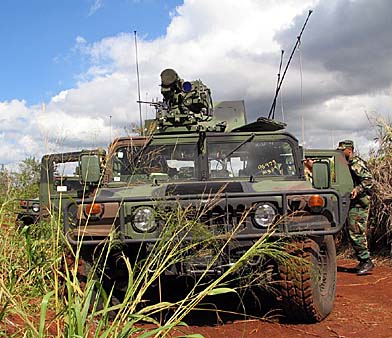
GREGG K. KAKESAKO / GKAKESAKO@STARBULLETIN.COM
Three new M707 Knight vehicles, which will be sent to Afghanistan next month with the 25th Infantry Division, will enable artillery forward observers to locate targets faster using lasers, and then transmit the information digitally rather than using voice communication. The same information can be relayed to pilots who are providing close air support to soldiers on the ground.
Test of technology
Army troops are training with
specially equipped Humvees to
prepare for duty in Afghanistan
Army Pvt. 1st Class Kevin Harvel stands in the turret of his olive Humvee, flanked by his M240B machine gun and his laser rangefinder on a bluff deep within enemy territory.
As an artillery forward observer, Harvel's job is to help soldiers of the 3rd Brigade, 25th Infantry Division, find the enemy before they get to the brigade or before the brigade goes forward.
For this training exercise, three new Humvees -- outfitted with special portable computers, radio equipment, satellite tracking devices and the ground vehicular laser location designator -- sit on a ridge at Schofield Barracks Area X.
The sound of rifle fire emanates from a nearby range and not from possible unfriendly natives.
When the forward observers call for artillery fire, no real rounds whistle overhead. Everything is simulated.
Last week, the 7th Field Artillery unit gave these vehicles, known as M707 Knights, their first field test at the Big Island's Pohakuloa Training Area as part of the "Sentry Strike" live-fire exercise. Working with Air Force forward controllers, 25th Division soldiers help pinpoint targets for artillery fire and F-16 jet fighters from the Montana Air National Guard.
All this training is to prepare the division's artillery cannoneers for the year they will be in Afghanistan beginning in mid-March.
GREGG K. KAKESAKO / GKAKESAKO@STARBULLETIN.COM
Sgt. John Carroll prepared to send target coordinates to a field artillery unit during a training exercise at Schofield Barracks on Friday.
Army Capt. Gabriel Zinni, the division artillery's fire control officer, said the 10th Mountain Division, which the 25th Division will replace in Afghanistan, is already using these specially equipped vehicles, which help the forward observers to more accurately locate targets and send the information digitally rather than by voice.
"Two more M707 Knights will be allocated to the 2nd Brigade next year when it returns from Iraq," Zinni said.
Zinni, 29, said each vehicle has a three-member combat observation lasing team, or COLT, considered the eyes and ears of the brigade.
Sgt. John Carroll, who operates the targeting computer from the cab of the Humvee, said the laser operated by Harvel collects information such as the direction, distance and vertical angle of the target.
"The computer does all the math and converts the information to either an eight- or 10-digit map grid coordinates," Carroll said.
The information is then relayed from his computer in a digital burst to the fire direction center, which is the brain of the artillery unit and controls where the guns shoot.
Carroll said information is used to determine whether the enemy's position will be hit by cannons, attack helicopters, close air support or even naval gun fire.
"The old way required the forward observer to visually spot the target using binoculars," Carroll said. "You had to be good at reading a map since you were required to plot the grid coordinates and then radio that information."
Carroll, who has been in the Army for nearly five years, said he likes the new technology.
"Once you get everybody on the same music sheet, it's really a smooth system," he said.
The ground vehicular laser location designator -- affectionately referred to as "Glid" by Schofield soldiers -- puts an invisible laser dot on a target up to 30 feet away.
Rick Dies, deputy director of the U.S. Army Training and Doctrine Command's Proponency Office, said that "as long as the operator can see the target using the laser, you can shoot it."
Used extensively during the first Gulf War in 1991, the ground vehicular laser location designator is about 25 years old.
Dies said a lighter version was developed two years ago and weighs only 35 pounds, compared to 107-pound version that is mounted on a Humvee.
"Technology allowed us to decrease the weight," Dies said.
For the past few weeks, Dies has been working with soldiers of the 3rd Battalion, 7th Field Artillery, "to ensure that fielding and training are successfully completed."
Last year, the Pentagon awarded a $14 million contract to Engineered Support Systems & Electronics Inc. to produce 37 Humvee-mounted Knight systems.

